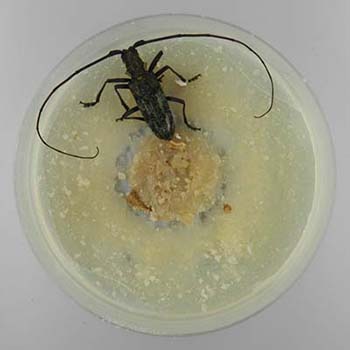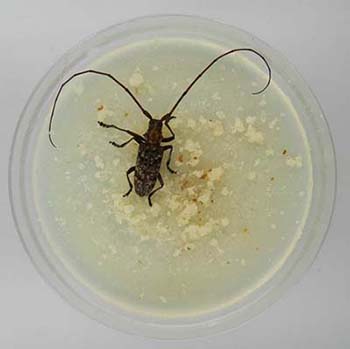Home > Research > Research Results > Research Results 2018 > The possible risk of pine wilt disease being spread by Monochamus grandis in northern regions
Update:March 5, 2018
Main content starts here.
The possible risk of pine wilt disease being spread by Monochamus grandis in northern regions
| Article title |
Effect of Monochamus grandis (Coleoptera: Cerambycidae) on phoretic stage formation of Bursaphelenchus xylophilus (Nematoda: Aphelenchoididae) and the transfer of nematodes to the beetle |
|---|---|
| Author (affiliation) |
Noritoshi Maehara (a), Natsumi Kanzaki (b), Takuya Aikawa (a), Katsunori Nakamura (a) (a) Tohoku Research Center, FFPRI, Morioka, Iwate, Japan (b) Kansai Research Center, FFPRI, Kyoto, Japan |
| Publication Journal |
Nematology, 20(1):43-48, 2018, DOI: 10.1163/15685411-00003123( External link ) |
| Content introduction |
The pine wood nematode (Bursaphelenchus xylophilus), which is the causative agent of pine wilt disease, has caused enormous damage to pine forests in East Asia (including Japan) and Portugal. In Japan, B. xylophilus is carried from wilt-killed to healthy Pinus spp. trees by Monochamus alternatus and kills healthy trees. M. grandis, which is closely related to M. alternatus and inhabits northern regions and high altitudes, mainly relies on Abies spp. for food and oviposition sites. Although there are documented cases of M. grandis using Pinus spp., it has not been confirmed as a vector of B. xylophilus. B. xylophilus is carried by M. alternatus as the fourth-stage dispersal juvenile, which can survive without food. It is known that the fourth-stage dispersal juvenile appears in the presence of M. alternatus. In this study, when we reared M. grandis in coexistence with B. xylophilus under laboratory conditions, fourth-stage dispersal juveniles appeared at levels comparable to those found with M. alternatus and were carried by M. grandis. This means that M. grandis can become a vector of B. xylophilus if they inhabit a tree together. Because M. grandis prefers Abies spp. to Pinus spp., contact with B. xylophilus is unlikely; hence, becoming a vector of B. xylophilus is also unlikely. However, if many Pinus spp. have died of wilt disease in areas inhabited by M. grandis, it is possible that M. grandis acts as a vector of B. xylophilus when using Pinus spp. for oviposition sites; therefore, caution is necessary.
Photo. Monochamus grandis (left) and M. alternatus (right) coexisting with Bursaphelenchus xylophilus (pine wood nematode) on agar media. M. grandis (length, 26–49 mm) is larger than M. alternatus (length, 14–27 mm). M. grandis can be distinguished from its closely related species by the conspicuous yellow bands on its lateral sites on the thorax. |
Copyright © Forest Research and Management Organization. All rights reserved.


